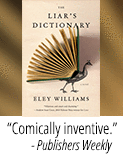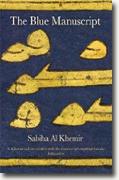

The Blue Manuscript is the story of a team of archaeologists who travel to Egypt in order to find a beautifully decorated copy of the Qu’ran from medieval times, an object that is absolutely priceless. One of its two volumes is found and bought by a collector at an incredibly low price. He realizes its value and takes it apart to sell it, page by page. Now the race is on to find the second volume.
is the story of a team of archaeologists who travel to Egypt in order to find a beautifully decorated copy of the Qu’ran from medieval times, an object that is absolutely priceless. One of its two volumes is found and bought by a collector at an incredibly low price. He realizes its value and takes it apart to sell it, page by page. Now the race is on to find the second volume.
 Each of the people on the team is fighting his or her own personal battles. Zohra, the translator, is caught between the Middle Eastern world and the archaeological team she is working with. “Glasses” won’t even tell people his real name, and Mark worries that the excavation is going too slow and fears that he won’t get paid. These and many other characters are only a part of the intricate and detailed story that is The Blue Manuscript
Each of the people on the team is fighting his or her own personal battles. Zohra, the translator, is caught between the Middle Eastern world and the archaeological team she is working with. “Glasses” won’t even tell people his real name, and Mark worries that the excavation is going too slow and fears that he won’t get paid. These and many other characters are only a part of the intricate and detailed story that is The Blue Manuscript .
.
There are a lot of characters in The Blue Manuscript , and much to keep track of. None of the characters are whole or undamaged; instead, each is fragile, something that is revealed over time. The book moves at a contemplative, self-reflective pace, enough time given for the reader to absorb what is going on in each storyline and with each person in the novel.
, and much to keep track of. None of the characters are whole or undamaged; instead, each is fragile, something that is revealed over time. The book moves at a contemplative, self-reflective pace, enough time given for the reader to absorb what is going on in each storyline and with each person in the novel.
That’s not to say that The Blue Manuscript is wordy – Sabiha Al Khemir has a beautiful writing style and doesn’t use flowery language or use multiple words where one will do. However, her prose is slow. It is quiet. She takes her time crafting each character, each subplot, making sure that they are exquisitely drawn, and her language sets the tone and pace of the novel. Some may find that the book moves too slowly to keep their interest, though that was not a problem for me.
is wordy – Sabiha Al Khemir has a beautiful writing style and doesn’t use flowery language or use multiple words where one will do. However, her prose is slow. It is quiet. She takes her time crafting each character, each subplot, making sure that they are exquisitely drawn, and her language sets the tone and pace of the novel. Some may find that the book moves too slowly to keep their interest, though that was not a problem for me.
At times, The Blue Manuscript flashes back to the calligrapher who wrote the Blue Manuscript in the Middle Ages. The historical flashbacks are effective, adding an entirely new dimension to the story, giving it a solid background and making the reader aware of the milieu and events that occured during the Manuscript’s creation. Khemir takes care not to overuse the device; she uses it well in order to show the reader, rather than tell them, about the Manuscript’s origins.
flashes back to the calligrapher who wrote the Blue Manuscript in the Middle Ages. The historical flashbacks are effective, adding an entirely new dimension to the story, giving it a solid background and making the reader aware of the milieu and events that occured during the Manuscript’s creation. Khemir takes care not to overuse the device; she uses it well in order to show the reader, rather than tell them, about the Manuscript’s origins.
The archeological dig serves as a narrative tool to explore many moral questions in The Blue Manuscript . Some are related to the excavation – for example, if an artifact is found on the land of a village, does it belong to the people of the village or to those who find it? This novel explores actions and their consequences. The characters discover something about themselves every time one of these questions is explored.
. Some are related to the excavation – for example, if an artifact is found on the land of a village, does it belong to the people of the village or to those who find it? This novel explores actions and their consequences. The characters discover something about themselves every time one of these questions is explored.
The Blue Manuscript is a well-written piece of literary fiction about a unique historical artifact. Though it has its rough spots, Khemir is an author to watch in the future if this book is any indication.
is a well-written piece of literary fiction about a unique historical artifact. Though it has its rough spots, Khemir is an author to watch in the future if this book is any indication.



 Each of the people on the team is fighting his or her own personal battles. Zohra, the translator, is caught between the Middle Eastern world and the archaeological team she is working with. “Glasses” won’t even tell people his real name, and Mark worries that the excavation is going too slow and fears that he won’t get paid. These and many other characters are only a part of the intricate and detailed story that is
Each of the people on the team is fighting his or her own personal battles. Zohra, the translator, is caught between the Middle Eastern world and the archaeological team she is working with. “Glasses” won’t even tell people his real name, and Mark worries that the excavation is going too slow and fears that he won’t get paid. These and many other characters are only a part of the intricate and detailed story that is